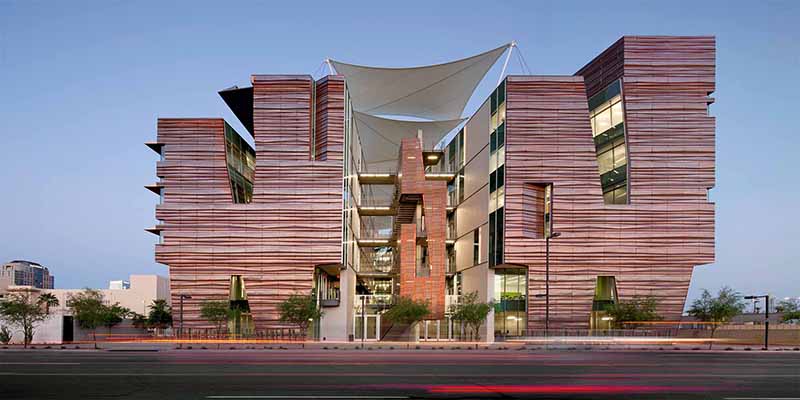
Description
The building on the Phoenix Biomedical Campus (PBC), 435 N. 5th Street, Phoenix 85004, includes flexible classrooms and state-of-the-art educational facilities, such as, simulation laboratories, gross anatomy facilities, preclinical training, learning resource center, student services and faculty office administrative space.
The HSEB creates an iconic identity for the University of Arizona School of Medicine on the Phoenix Biomedical Campus and responds to its urban locale and desert environment. The Arizona desert climate and need for reduced energy consumption informed much of the design, from the way the building is sited at its location to the type of fenestration and the innovative cooling methods used. Inspired by the iconic canyon formations found throughout Arizona, the façade reinterprets stratified earth layers revealed over time as a copper sunscreen protecting the exterior building enclosure from direct solar exposure. Akin to the natural forces that shape the Earth’s geology, the copper skin is fissured, formed, bent, pressed, and perforated, creating beauty from a functional building need. The architectural design promotes physical connectivity to the downtown Phoenix community with indoor and outdoor spaces that encourage interaction.
Projected Ultimate Budget
Construction Project Manager
D P R / Sundt (A Joint Venture)
1st Place Façade Award, World Architecture News, 2014
Named one of the most beautiful research labs in the world, Gizmodo.com, 2015
Education Facility Design Award of Excellence, AIA Committee for Architecture in Education, 2015
Merit Award for Architectural Design, AIA Arizona, 2013
Best Project - Higher Education/Research, ENR Southwest, 2013
Award of Merit, Arizona Forward Environmental Excellence Awards, Buildings and Structures - Institutional, 2013
Stellar Architecture Using BIM, AIA Technology in Architectural Practice (TAP) Building Information Model Awards, 2013
Merit Award for Architectural Design, AIA Western Mountain Region, 2013
Honor Award for Architectural Design, AIA California Council, 2013
North American Copper in Architecture Award, Copper Development Association, Inc. & Canadian Copper and Brass Development Association, 2013
Design Award - Natural Metal Category, Metal Architecture, 2013
Best of LA Architects Award, Los Angeles Business Council
AZRE Red Awards: Most Challenging Project, 2013
Citation, 'Next LA' Awards, AIA Los Angeles, 2010


Please try viewing in landscape mode.

The HSEB draws its design inspiration from surrounding mountains and canyons, and it responds to local climactic conditions characterized by intense sunlight and extreme temperatures. Inspired by the iconic canyon formations found throughout Arizona, the facade reinterprets stratified earth layers as a copper sunscreen protecting the building from direct solar exposure. The copper skin is formed, bent, pressed and perforated to create a visual connection to the surrounding mountain range. The "canyon" is the building's central organizing element. It is clad in burnished concrete building block to provide cool thermal mass and reflectivity; it is shaped to maximize self-shading, allowing light from, and visual connection to, the exterior. Defined by two academic wings and the "mixing bar", this exterior space is protected overhead by a fabric structure, and tempered with landscaping and semi-conditioned relief air. This relief air of the building is introduced at the first-floor level, cooling the space, as the ambient temperature can be well over 100 degrees Fahrenheit.

The copper cladding creates long horizontal sunscreens on the south elevation to provide shading for the generous openings. North elevations were provided with vertical fins to block the low sun towards the end and beginning of summer days. With the desire to minimize direct sun intrusion into the interior spaces, the building was computer modeled, and sun exposure simulated for every day of the year. The modeling tested the efficacy of the shading devices and informed their design. Generally, very few openings were introduced at the east and west facades. These walls have incisions that introduce light through facets protected from direct east or west sun. The ground level of the east facade abuts the main campus quad and is the primary entry for the building. This lower elevation was provided with glazed walls that welcome the outdoors, but were provided large copper overhangs to provide maximum shading.

The building is designed to be highly sustainable by minimizing waste of every kind. Mechanical systems are engineered to be highly efficient and easy to maintain. The canyon space, shaded from above and the sides, is made comfortable through the introduction of tempered "waste" building relief air which would normally have been exhausted to the roof of the building. Lighting is designed to be highly efficient and augmented wherever possible by controlled daylight. Interior materials selected were chosen for durability and beauty, as well as for their high-recycled content.